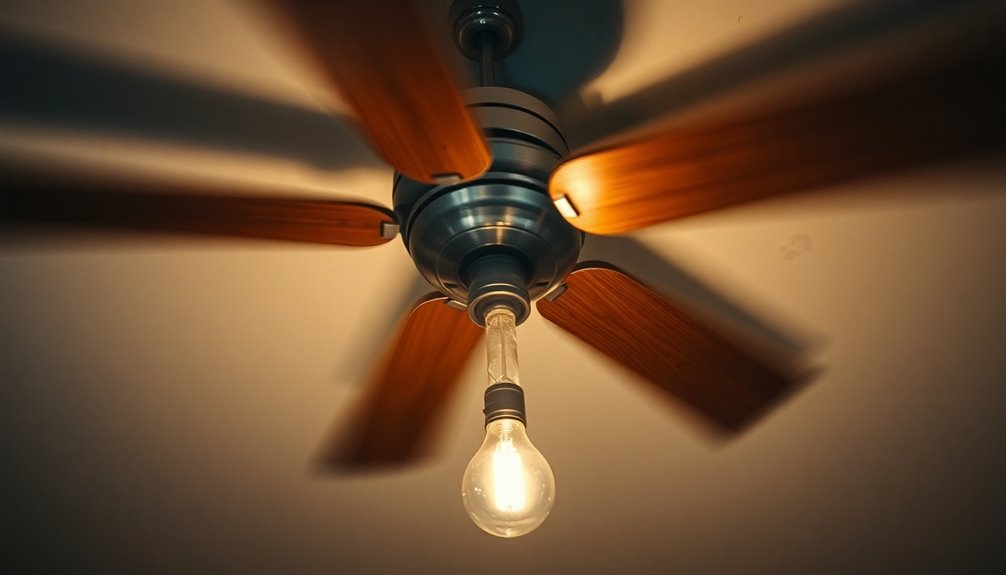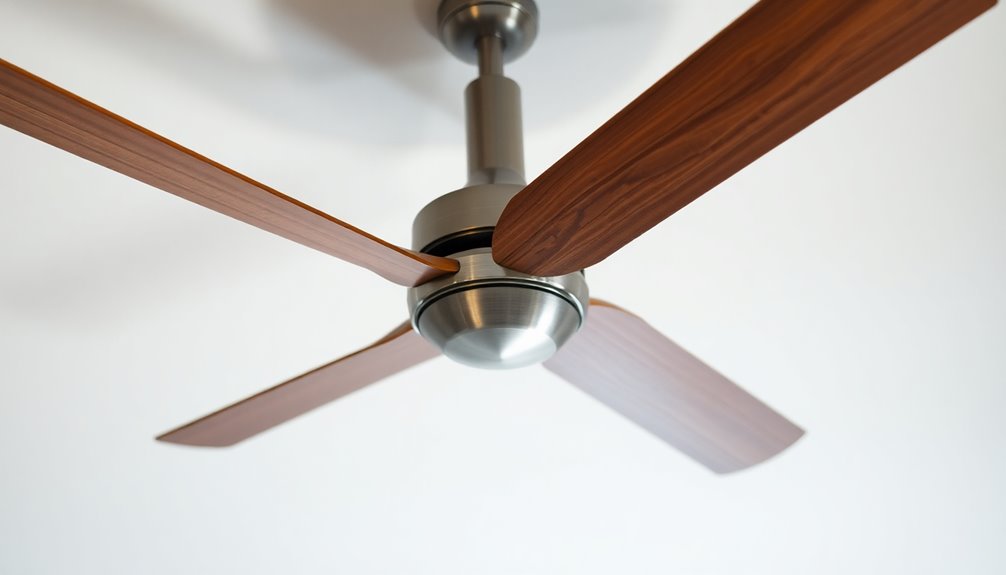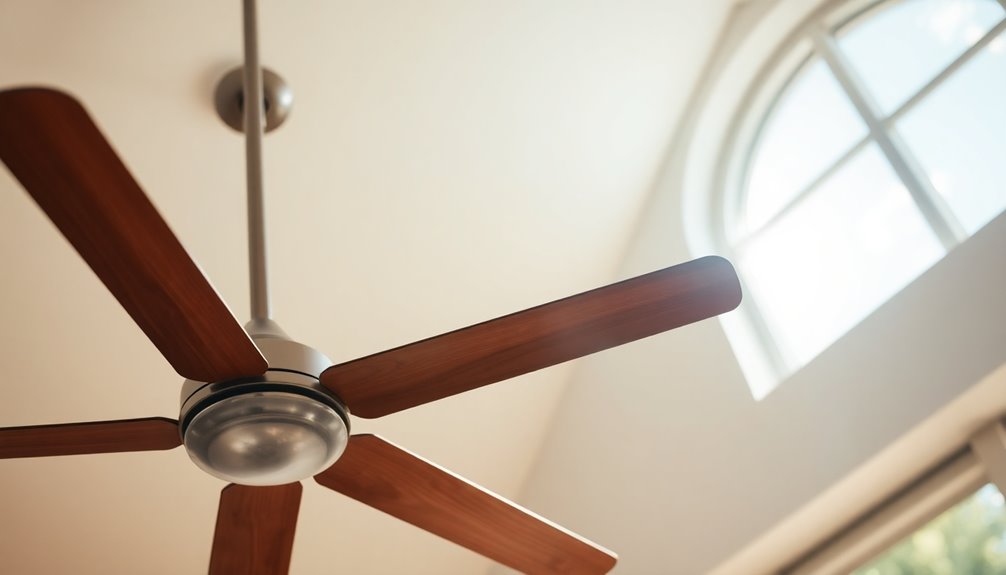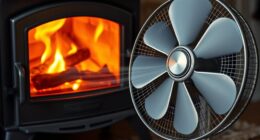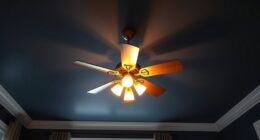Running a ceiling fan uses surprisingly little electricity compared to other cooling options, making it a smart choice for staying comfortable. Typically, these fans consume only 50 to 80 watts per hour, much less than air conditioning units, which can pull 750 to 3,500 watts. In fact, you might spend only around 5 cents a day running your fan for six hours. If you opt for an Energy Star-rated model, you could save even more on your energy bills. Curious about other ways to maximize efficiency and reduce costs? There's plenty more to explore on this topic!
Key Takeaways
- Ceiling fans consume significantly less electricity than air conditioning units, using only 50 to 100 watts per hour.
- A typical ceiling fan, like the Harbor Breeze, costs about $18.77 annually for 8 hours of daily use.
- Running a ceiling fan for 6 hours costs around 5 cents, much lower than air conditioning costs exceeding $1.20.
- Energy-efficient fans can save up to 60% in electricity usage compared to non-rated models, making them a cost-effective option.
- Regular maintenance and proper use can enhance a ceiling fan's efficiency, further reducing electricity consumption.
Ceiling Fan Energy Consumption

When it comes to energy consumption, ceiling fans are a cost-effective choice for cooling your home. Ceiling fans consume between 50 to 80 watts per hour, a stark contrast to air conditioning units, which can drain anywhere from 750 to 3500 watts.
For instance, a Harbor Breeze ceiling fan operates at just 38 watts on high speed, leading to an approximate annual energy consumption of $18.77 when used for 8 hours daily. You'll find that running a standard ceiling fan for 6 hours costs about 5 cents, while using air conditioning can skyrocket to over $1.20 for the same duration. This significant difference showcases the energy efficiency of ceiling fans as cooling devices. Additionally, using ceiling fans can enhance overall well-being by improving air circulation in your living space. HEPA filtration is another home improvement that can significantly improve indoor air quality, complementing the effects of ceiling fans. Furthermore, heat pumps can provide an efficient alternative for heating and cooling, enhancing overall energy savings, especially in commercial settings where larger climate control systems are needed.
Energy Star-rated models are even better, being 60% more efficient than non-rated options, which means more savings on your electricity bills.
When you consider the average cost of electricity, the typical annual energy consumption for a ceiling fan ranges from 146 to 219 kWh. Additionally, regular maintenance of cooling systems, such as heat pump servicing, can further enhance energy efficiency in your home.
In short, if you're looking to minimize electricity usage while staying cool, ceiling fans are a smart choice for your home.
Calculating Electricity Costs

Calculating the electricity costs of running a ceiling fan is straightforward and essential for budgeting your cooling expenses. The cost largely depends on the ceiling fan's wattage, the duration of use, and your local electricity rate. Typically, ceiling fans use between 50 to 80 watts per hour, resulting in daily energy consumption of about 0.05-0.075 kWh.
Here's a quick breakdown of costs for different fan wattages:
| Fan Wattage | Daily Cost (8 hours) |
|---|---|
| 38W | $0.05 |
| 75W | $0.054 |
| 80W | $0.057 |
At an average electricity rate of $0.169 per kilowatt-hour, the annual costs for running a ceiling fan can be quite low, around $18.25 to $18.77. This makes ceiling fans a cost-effective cooling device compared to air conditioning systems, which consume much more energy. By understanding your fan's watts per hour and your electricity consumption, you can efficiently manage your cooling expenses while using less power.
Ceiling Fans vs. Other Appliances

When you compare ceiling fans to other cooling appliances, you'll see just how efficient they really are.
While a ceiling fan uses only 50 to 100 watts per hour, air conditioners can ramp up to 3,500 watts depending on the model.
This stark difference in energy consumption not only impacts your electricity bill but also highlights the cost-effectiveness of ceiling fans in your cooling strategy.
Ceiling Fan Efficiency
Ceiling fans' efficiency shines when compared to other appliances, especially air conditioning units.
You'll find that ceiling fans typically consume between 50 to 80 watts per hour, a stark contrast to air conditioners that can use between 750 to 3500 watts.
When you consider running a standard ceiling fan for 8 hours a day, it costs around $18.77 annually. In comparison, an efficient window air conditioner can rack up over $81.50 for the same usage.
High-efficiency models, like the Aeratron ceiling fan, consume as little as 16.2 watts, leading to an annual cost of just about $8.00.
Even tower fans, such as Lasko models, aren't as efficient, consuming around 48 watts and costing about $24.00 annually.
Cost Comparison Analysis
Many homeowners underestimate the cost-effectiveness of ceiling fans compared to other cooling appliances.
When you run a standard ceiling fan for about 8 hours a day, it only costs you around $0.05 daily, or about $18.77 annually. This is a fraction of the cost of running an air conditioner, which can consume between 750 to 3,500 watts and result in annual costs of around $81.50.
Even box fans, which use 60 to 110 watts, can lead to annual costs ranging from $30 to $54.
Tower fans are slightly better, averaging about 48 watts, but still cost around $24 a year to operate.
Energy-efficient ceiling fans, especially those rated by Energy Star, can save you even more by reducing electricity usage by up to 60% compared to non-rated models. Additionally, using ceiling fans in conjunction with an air purifier can enhance overall indoor air quality while keeping energy costs lower.
Seasonal Fan Direction

Adjusting your fan's direction with the changing seasons can greatly impact your comfort and energy bills.
In the summer, you should set your ceiling fans to rotate counterclockwise. This creates a cooling breeze that helps you feel more comfortable, allowing you to raise your thermostat settings by up to 4°F without sacrificing comfort. This simple seasonal fan adjustment can considerably reduce cooling costs and enhance energy efficiency. Additionally, using a ceiling fan can complement your heat pump system, further optimizing your home's temperature management. The effectiveness of this cooling strategy is especially pronounced in systems that utilize the refrigeration cycle, as they work synergistically to manage indoor temperatures. Keeping your home well-maintained with proper ventilation can further improve the effectiveness of your cooling methods. It's advisable to consider weather patterns when planning your cooling strategy, as they can influence your fan's performance.
As winter approaches, it's crucial to reverse your fan's direction to clockwise. This change circulates warm air that rises to the ceiling, improving heating efficiency. By utilizing the correct fan direction, you can effectively reduce heating costs while maintaining a cozy environment. Properly functioning ceiling fans can enhance the performance of your heat pump by ensuring even distribution of warm air throughout the space. Regularly checking your fan's performance helps ensure that it operates at optimal levels throughout the year. Using ceiling fans in winter can also complement your heating system, reducing the need for excess energy use.
Many ceiling fans come equipped with a directional switch or remote control, making it easy to switch between settings. These seasonal fan adjustments not only enhance air circulation but also optimize indoor comfort. Additionally, regular maintenance of your ceiling fan, such as cleaning and checking for dust buildup, can further enhance its efficiency and prolong its lifespan.
Energy.gov highlights that using your ceiling fans correctly can minimize electricity consumption throughout the year. So, don't overlook the power of your ceiling fans—adjusting their direction according to the seasons can lead to a more comfortable home and lower energy bills.
Balancing Your Ceiling Fan

Balancing your ceiling fan is essential for ensuring it runs efficiently and lasts longer.
When properly installed and maintained, a balanced fan minimizes strain on the motor, saving you money on energy bills.
Regular checks can help you catch any wobbling issues early, keeping your fan performing at its best.
Importance of Proper Installation
When it comes to enjoying the cool breeze from your ceiling fan, proper installation is vital for ideal performance. If your fan isn't securely mounted and all screws are tight, it can lead to wobbling. This wobbling not only creates noise but also increases wear on the fan, which may raise your energy consumption over time.
To achieve optimal airflow and energy efficiency, measure the distance between the fan blades and the ceiling during installation. This guarantees smooth operation and minimizes the chances of wobbling.
Regular cleaning of the fan blades is also important; dust buildup can affect balance and airflow, leading to inefficiencies. Additionally, neglecting maintenance may lead to problems such as mechanical failure that can further compromise energy efficiency.
If you notice wobbling despite thorough checks, consider using a ceiling fan balance kit. This simple tool can help you achieve proper balance, enhancing your fan's performance while reducing unnecessary energy consumption.
Maintenance for Optimal Performance
A well-maintained ceiling fan not only enhances comfort but also maximizes energy efficiency. A wobbly ceiling fan can consume more electricity, so it's vital to guarantee proper balance for peak performance. Regular maintenance, like checking and tightening screws, can prevent wobbling and boost your fan's energy efficiency.
Here's a quick reference table to guide you:
| Maintenance Task | Benefits |
|---|---|
| Cleaning the fan blades | Reduces dust accumulation |
| Tightening screws | Enhances balanced operation |
| Measuring blade distance | Guarantees even airflow |
| Using a balance kit | Achieves stability |
Cleaning the fan blades is another important step. It not only helps maintain balanced operation but also prevents unnecessary energy consumption. If you find that wobbling persists after these adjustments, don't hesitate to use a ceiling fan balance kit. This will promote energy-efficient operation, allowing your fan to work effectively without straining your electricity bill. By implementing these maintenance tips, you'll enjoy a well-functioning ceiling fan that saves energy and keeps you comfortable. Additionally, maintaining high vibrational energy around your environment can enhance your overall manifestation abilities, allowing you to attract more comfort and efficiency into your life.
Energy Efficiency Tips

Ceiling fans can be a great ally in your quest for energy efficiency, but maximizing their benefits requires some smart habits.
Start by investing in Energy Star-rated ceiling fans, as they're about 60% more efficient than non-rated models, which can greatly lower your electricity bills. Additionally, using ceiling fans can complement heat pumps in maintaining a comfortable indoor climate. Consider that using home security systems can also enhance your overall energy management by integrating with smart devices. According to recent evaluations, the best home security systems of 2025 emphasize features that can contribute to energy efficiency. Furthermore, integrating smart utilities can help optimize energy consumption across your home.
Remember to turn off your ceiling fans when rooms are unoccupied. Fans don't cool air; they simply circulate it, so running them in empty spaces is a waste of energy.
To further reduce air conditioning costs, adjust your thermostat setting upward by 4°F while using a ceiling fan. This small change can enhance comfort without straining your cooling devices.
Selecting the right fan size is also essential. For rooms up to 400 square feet, a 52-inch fan optimizes airflow and energy usage.
Finally, don't overlook maintenance. Regularly cleaning your ceiling fans improves their performance and efficiency, ultimately decreasing energy consumption. Additionally, using ceiling fans alongside energy-efficient vacuums can help maintain a cleaner environment, which supports overall air quality and comfort. Investing in expandable home security systems can also help you adapt your energy use as your needs change.
Frequently Asked Questions
Can Ceiling Fans Cause High Electric Bill?
Ceiling fans generally won't cause a high electric bill. They consume considerably less energy compared to air conditioning units.
Running one for several hours each day usually costs you only a few cents. If you're using it alongside air conditioning, you can even raise your thermostat setting without sacrificing comfort, leading to further savings.
How Much Does It Cost to Leave a Ceiling Fan on All Day?
If you leave a ceiling fan on all day, it'll cost you about $0.20 to $0.32, depending on your model and local electricity rates.
That adds up to around $6 to $9.60 a month for continuous use.
Compared to running an air conditioner, which can be considerably more expensive, a ceiling fan's operation is a budget-friendly option for keeping your space comfortable during warmer months.
Is It Cheaper to Run Ceiling Fans or Air?
When you compare running ceiling fans to air conditioning, you'll find that ceiling fans are much cheaper.
They use considerably less electricity, costing around $18 to $20 a year. In contrast, air conditioners can rack up costs of $81.50 or more annually.
Plus, with a ceiling fan, you can set your thermostat higher without losing comfort, saving even more on energy bills.
It's a smart choice for both comfort and cost efficiency!
Is It Okay to Leave Ceiling Fans on All the Time?
You know that moment when you walk into a room and feel the instant relief from a ceiling fan?
It's tempting to leave it on all the time. While it's generally okay to run it when you're around, turning it off when you leave can save you some extra electricity.
Conclusion
In the grand scheme of your energy bill, running a ceiling fan is like adding a sprinkle of salt to your meal—hardly noticeable but definitely enhances the flavor. You'll find that it uses far less electricity than many other appliances, making it a smart choice for comfort without breaking the bank. So, embrace the breeze and keep your space cool; it's an efficient way to enjoy your home while keeping costs down.

